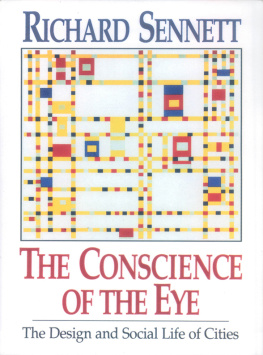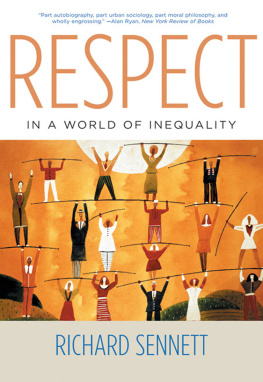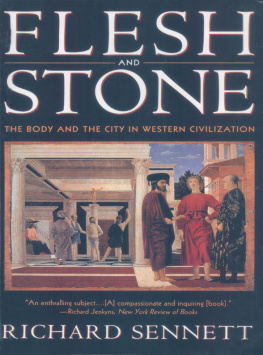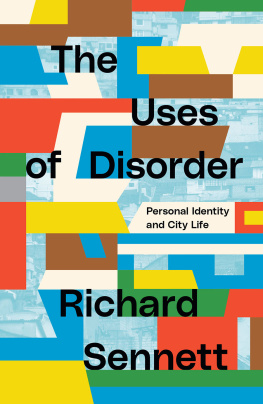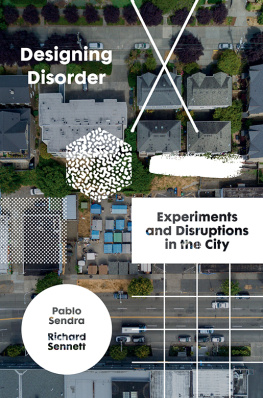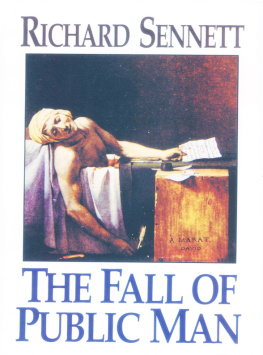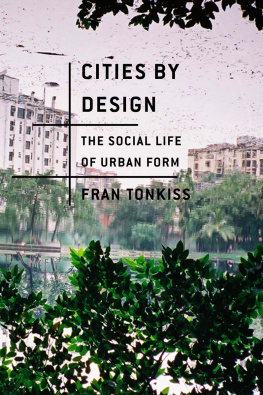The
Conscience
of the
Eye
The Design
and Social Life
of Cities
RICHARD
SENNETT
W. W. NORTON & COMPANY
New York London
Copyright 1990 by Richard Sennett
All rights reserved under International and Pan-American Copyright Conventions.
First published as a Norton paperback 1992 by arrangement with Alfred A. Knopf, Inc.
Library of Congress Cataloging-in-Publication Data Sennett, Richard, 1943
The conscience of the eye : the design and social life of cities / Richard Sennett.
p. cm.
Includes index.
eISBN 9780393346497
1. City and town life. 2. City and town life--History. 3. Sociology, Urban. 4. Public spaces. I. Title.
HT231.S458 1992
307.76--dc20
92-13143
CIP
ISBN 0393308782
ISBN 9780393346497 (ebook)
W. W. Norton & Company, Inc.
500 Fifth Avenue, New York, N.Y. 10110
www.wwnorton.com
W. W. Norton & Company Ltd.
Castle House, 75/76 Wells Street, London W1T 3QT
For Saskia Sassen
From early on I have suspected that the so important-sounding task Know thyself is a ruse of a cabal of priests. They are trying to seduce man from activity in the outside world, to distract him with impossible demands; they seek to draw him into a false inner contemplation. Man only knows himself insofar as he knows the worldthe world which he only comes to know in himself and himself only in it.
GOETHE
Contents
PART ONE
Interior
Shadows |
PART TWO
The Eye
Searches
for Unity |
PART THREE
The
Humane
City |
PART FOUR
The Art of
Exposure |
THE ANCIENT GREEK could use his or her eyes to see the complexities of life. The temples, markets, playing fields, meeting places, walls, public statuary, and paintings of the ancient city represented the cultures values in religion, politics, and family life. It would be difficult to know where in particular to go in modern London or New York to experience, say, remorse. Or were modern architects asked to design spaces that better promote democracy, they would lay down their pens; there is no modern design equivalent to the ancient assembly. Nor is it easy to conceive of places that teach the moral dimensions of sexual desire, as the Greeks learned in their gymnasiumsmodern places, that is, filled with other people, a crowd of other people, rather than the near silence of the bedroom or the solitude of the psychiatrists couch. As materials for culture, the stones of the modern city seem badly laid by planners and architects, in that the shopping mall, the parking lot, the apartment house elevator do not suggest in their form the complexities of how people might live. What once were the experiences of places appear now as floating mental operations.
We could never recover the Greek past, even if we wished and we would not wish to; their city was founded on massive slavery. But the clarity with which they could literally see the fullness of life raises at least the question of why we cannot see as fully, a question this book attempts to answer.
One difference between the Greek past and the present is that whereas the ancients could use their eyes in the city to think about political, religious, and erotic experiences, modern culture suffers from a divide between the inside and the outside. It is a divide between subjective experience and worldly experience, self and city. Moreover, our culture is marked by hard struggle whenever people seek to make inner life concrete. This sets us off not just from our own origins but also from non-European cultures nearer in time whose masks, dances, ceremonials, shrines, sacred grounds, and cosmologies connect subjective life to physical things.
This divide between inner, subjective experience and outer, physical life expresses in fact a great fear which our civilization has refused to admit, much less to reckon. The spaces full of people in the modern city are either spaces limited to and carefully orchestrating consumption, like the shopping mall, or spaces limited to and carefully orchestrating the experience of tourism. This reduction and trivializing of the city as a stage of life is no accident. Beyond all the economic and demographic reasons for the neutralized city there exists a profound, indeed, spiritual reason why people are willing to tolerate such a bland scene for their lives. The way cities look reflects a great, unreckoned fear of exposure. Exposure more connotes the likelihood of being hurt than of being stimulated. The fear of exposure is in one way a militarized conception of everyday experience, as though attack-and-defense is as apt a model of subjective life as it is of warfare. What is characteristic of our city-building is to wall off the differences between people, assuming that these differences are more likely to be mutually threatening than mutually stimulating. What we make in the urban realm are therefore bland, neutralizing spaces, spaces which remove the threat of social contact: street walls faced in sheets of plate glass, highways that cut off poor neighborhoods from the rest of the city, dormitory housing developments.
In this book I shall try to show how fear of exposure came about, how the wall between inner and outer life was built. The wall arose in part from our religious history: Christianity set Western culture upon the course that built a wall between the inner and outer experience. The shadows cast by that wall continue to darken secular society. Moreover, attempts to unify the inner and outer dimensions simply by tearing down the wall, making the inner and outer one organic whole, have not proved successful; unity can be gained only at the price of complexity.
The exposed, outer life of the city cannot be simply a reflection of inner life. Exposure occurs in crowds and among strangers. The cultural problem of the modern city is how to make this impersonal milieu speak, how to relieve its current blandness, its neutrality, whose origin can be traced back to the belief that the outside world of things is unreal. Our urban problem is how to revive the reality of the outside as a dimension of human experience.
In battle, at the deathbed, or simply on the street, the ancient Greek was hardly a mushy, good-hearted sentimentalist, moved to tears whenever he or she witnessed the pain of another. The value of witnessing both difficulty and diversity was instead thought to be that through exposure to the world the individual gradually found his or her orientation, found how to keep a balance. This condition the Greeks called sophrosyne, which could be translated as grace or poise. Today we would say such a person keeping his or her balance in the world is centered. A city ought to be a school for learning how to lead a centered life. Through exposure to others, we might learn how to weigh what is important and what is not. We need to see differences on the streets or in other people neither as threats nor as sentimental invitations, rather as necessary visions. They are necessary for us to learn how to navigate life with balance, both individually and collectively.
This might seem a matter simply of reflecting upon what we see, of reckoning our places in the midst of others. But for the Greeks, to balance oneself one had to act as well as to look. The result of caring about what one sees is the desire to make something. The Greeks called this desire

